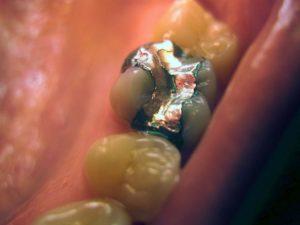 As the case for dental mercury grows weaker and weaker, you can see its champions changing tactics to support their use of this dental material.
As the case for dental mercury grows weaker and weaker, you can see its champions changing tactics to support their use of this dental material.
Instead of addressing evidence of its toxicity, they praise its longevity, durability and ease of use. They say that the mercury used in amalgam isn’t “the bad kind” (that is, methylmercury), glossing the fact that the vapor released from fillings becomes methylated in the mouth and elsewhere in the body.
And if all else fails, they turn to the dangers of bisphenol A (BPA), which is found in some kinds of composite (“white filling”) materials.
But this confuses safety with effectiveness – and thereby skirts the issue of dental mercury all together. As Dr. Michael Fleming reminded folks earlier this year in a fascinating article on the future of amalgam,
Safety concerns with one product or device are not related to those of a different device. Within the regulatory framework, this means that any alleged health concerns surrounding composite use are unrelated to matters of safety with amalgam. Thus, one cannot successfully argue for continuing the use of amalgam on the basis that composites may turn out to be unsafe in some way. [emphasis added]
 But even so, should you be concerned about BPA being released from “white” fillings or sealants?
But even so, should you be concerned about BPA being released from “white” fillings or sealants?
BPA, of course, is a concern. It’s a known endocrine disruptor that may contribute to physical and neurological problems during early developmental stages in a person’s life. Research has also shown it to interfere with proper thyroid function and possibly be carcinogenic.
And a few years ago, a paper published in Pediatrics confirmed that it is, in fact, released from some dental materials.
Yet concerns were dismissed. The amount of BPA released was negligible, said the researchers, and could be reduced through certain chairside practices. However, when another study in the same journal suggested a link between BPA in dental materials and behavioral issues in children, there was plenty of concern, which was used to justify continued use of amalgam, along with stainless steel.
Yet this study didn’t measure BPA at all. While children with composites containing the substance did show more behavior problems, those with BPA-free composites showed no change in behavior scores.
And this brings us to the crux of the matter: While ALL amalgam fillings contain mercury, NOT all composites contain BPA.
In our office, Dr. Glaros does his research to make sure that all the resins we use are BPA-free. Those that do release the substance aren’t even considered. He also insists on materials testing for every patient, making every effort to ensure that what we put on or in the teeth is safe and biocompatible. We think this is just good, common sense. After all, our job is to help people achieve and sustain their preferred level of oral and systemic health. To use anything that would compromise that would make no sense.
But what if you already have composites or sealants? Should you be concerned?
First, know that when BPA is present in a composite resin, the amount released is very small – though like so many environmental toxins, it is bioaccumulative and may add to your total body burden. Still, if the dental work involved isn’t causing any immediate health problems that either you experience or are detected through EAV or other testing techniques, removing the composite is apt to do more harm than good. The trauma each tooth would undergo through the removal process would do more harm than any benefit of lower BPA exposure would give.
Eventually, they will need to be replaced due to age and wear (which can be as long as 10 or even 20 years for some materials). That’s when to make sure they’re replaced with a BPA-free, biocompatible material.
In the meantime, there are measures you can take to help prevent the absorption of BPA by your bodily tissues. And the more you can reduce your exposure to it from other sources, the better.
For a good – though technical – overview of the research on BPA release from dental materials, see this article.
Composite filling image by Albert, via Wikimedia Commons